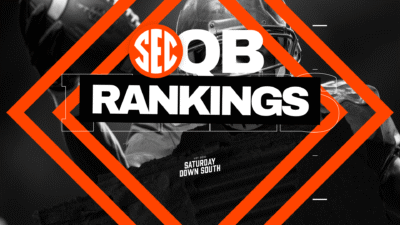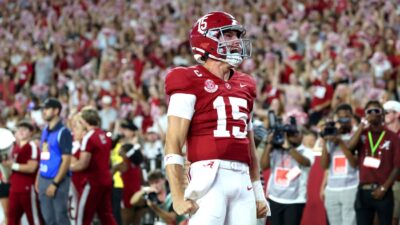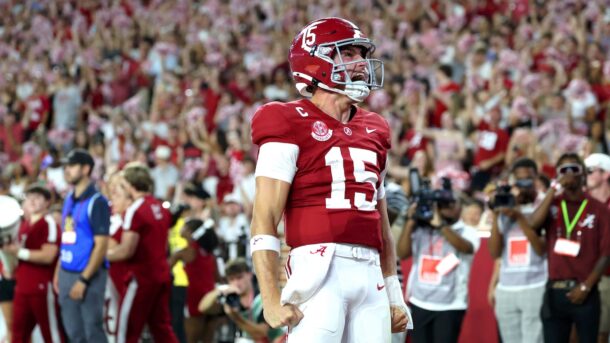Multiple awards are presented each season to recognize the best player in college football.
There’s the Maxwell Award, the Walter Camp Award and the Associated Press Player of the Year, to name a few. But they all pale in prestige and importance to the Heisman Memorial Trophy.
It’s the honor everyone remembers and defines the winner’s career no matter what, if anything, he goes on to do in the NFL.
Here’s an in-depth look at the most recognizable individual award in sports and everything there is to know about the Heisman Trophy:
- Latest Heisman Trophy odds
- Complete list of Heisman Trophy winners
- Biggest Heisman snubs
What Is The Heisman Trophy?
According to Heisman.com, the award is presented each season to “the most outstanding college football player in the United States whose performance epitomizes great ability combined with diligence, perseverance and hard work.”
It was created by the Downtown Athletic Club in New York and has been awarded annually since 1935. The award is named after John W. Heisman, a college football pioneer who earned distinction as coach at Auburn, Georgia Tech, Clemson, Rice, and several other schools and was the athletic director of the Downtown Athletic Club.
Who Is The Player Depicted on The Trophy?
Everyone who cares about college football knows what the Heisman looks like. It’s a statue depicting a determined, leather-helmeted runner in full stride cradling a ball in his right hand while administering a stiff-arm with his left.
However, few, if anyone, know that the player the trophy is modeled after is Ed Smith of New York University, one of the nation’s top players during the 1934 season.
The original design was created by sculptor Frank Eliscu, a high school classmate of Smith who asked the player to pose for a sculpture on which he was working. It wasn’t until nearly a half-century later, in 1982, that Smith learned that the sculpture was actually the Heisman Trophy. He was presented an honorary Heisman by the Downtown Athletic Club in 1985.
The bronze statue is 13.5 inches tall, 14 inches long and weighs 45 pounds. It is made from cast bronze and since 2005 has been cast by MTM Recognition of Del City, Oklahoma.
How Is The Heisman Winner Selected?
The award is selected by a panel of 929 voters, composed of media members divided equally among 6 regions across the country (Far West, Mid-Atlantic, Southwest, Northeast, Midwest and South), along with previous Heisman winners and 1 vote reserved for the winner of an online fan poll.
Each voter is asked to identify 3 choices ranked in order, with first-place votes receiving 3 points, second-place votes getting 2 points and third-place votes 1 point. Once the voting is done, the accounting firm of Deloitte Touche Tohmatsu Limited tabulates and certifies the results. Players deemed as finalists by the Heisman Trust are invited to the Heisman award ceremony in New York, with the candidate receiving the highest point total awarded the trophy.
Who Is Eligible to Win The Heisman?
Although any player at any position in college football can win the award, it significantly enhances your chances if you play on offense in general and quarterback specifically.
Although more running backs have won the Heisman than any other position, the trend has shifted dramatically since the turn of the century. Of the 25 winners since 2000, 20 have been quarterbacks.
Only 2 Heisman winners since the advent of the 2-platoon system have played extensively on defense. Charles Woodson of Michigan in 1997 was the first. Colorado’s Travis Hunter joined him in 2024. Both played defensive back and wide receiver.
In all, 44 running backs have won the Heisman, 38 quarterbacks, 4 wide receivers, 2 tight ends and 2 “others.” Sixty-one Heisman winners earned the award during their senior season. Twenty-one juniors, 6 sophomores and 2 redshirt freshmen – Texas A&M’s Johnny Manziel in 2012 and Florida State’s Jameis Winston in 2013 – have also won the Heisman. A true freshman has never won the award.
Who Won The first Heisman?
It depends on how you interpret the question.
Jay Berwanger, a running back from the University of Chicago, was the first to win the trophy in 1935. But at the time, it was known as the Downtown Athletic Club Trophy. The first winner to receive the award as the Heisman Trophy, as it was renamed following Heisman’s death, was 1936 winner, Yale tight end Larry Kelly.
The award was originally created to recognize the best college football player from a school East of the Mississippi. In addition to the new name, players from all across the country became eligible in 1936. It took 2 more seasons, until 1983, for TCU quarterback Davey O’Brien to become the first Western player to win.
The first Black Heisman winner was Syracuse running back Ernie Davis, who won the award in 1961, not long before being diagnosed with leukemia. He died 2 years later from the disease.
Has Anyone Won 2 Heisman Trophies?
The only multiple winner was Ohio State running back Archie Griffin.
He won his first Heisman as a junior in 1974, leading the Buckeyes to a 10-1 season and No. 3 national ranking by rushing for a career-high 1,620 yards and 12 touchdowns. The following season, he rushed for 1,357 yards and 7 touchdowns on a top-ranked team that went 11-0 to beat out Cal’s Chuck Muncie and USC’s Ricky Bell for his second Heisman.
Besides Griffin, the closest anyone has come to winning a second Heisman was Tim Tebow. The 2007 winner came in third in the 2008 balloting, just 151 points behind winner Sam Bradford of Oklahoma. Tebow actually got more first-place votes than Bradford (309-300), but still finished behind both Bradford and Texas’ Colt McCoy.
Georgia’s Herschel Walker came close twice before finally winning his Heisman as a junior in 1982. He finished third as a freshman in 1980 behind winner George Rogers of South Carolina and Pittsburgh defensive end Hugh Green. In 1981, he finished a distant second to USC running back Marcus Allen.
Which Schools Have Produced The Most Heisman Winners?
USC has had the most winners with 8 (RB Mike Garrett in 1965, RB OJ Simpson in 1968, RB Charles White in 1979, RB Marcus Allen in 1981, QB Carson Palmer in 2002, QB Matt Leinart in 2004, RB Reggie Bush in 2005 and QB Caleb Williams in 2022).
Notre Dame, Ohio State and Oklahoma are next with seven winners each, followed by Alabama with 4, and the group of Army, Auburn, Florida, Florida State, LSU, Michigan and Nebraska with 3 each.
Colorado, Georgia, Miami, Navy, Texas, Texas A&M, Wisconsin and Yale have each had 2 winners while Baylor, BYU, Boston College, Chicago, Houston, Iowa, Louisville, Minnesota, Oklahoma State, Oregon, Oregon State, Penn State, Pitt, Princeton, South Carolina, SMU, Stanford, Syracuse, TCU and UCLA have all had 1.
Award-winning columnist Brett Friedlander has covered the ACC and college basketball since the 1980s.





